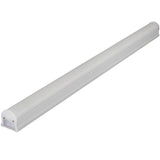Upgrade T8 Fluorescent Lamps to Improve Light Quality in Classrooms
Posted by Dave on for ProLampSales

There have been several studies in the last few years documenting the positive affect of daylight on student alertness and academic performance in classrooms. Today, daylight harvesting is a major component of integrated lighting designs for newly built schools.
For existing schools and universities, expensive remodels to bring more natural light into the classroom may not be feasible. The next best option is to upgrade existing fluorescent lighting with the goal of improving lighting quality.
Optimized, non-glare illumination on student desks is certainly priority one in a quality lit classroom. However, the color characteristics of the light prove to be almost as important. Improved color rendering in particular is one way to bring some of the benefits of daylight into the learning environment.
Color rendering describes how a light source makes the color of an object appear to human eyes and how well subtle variations in color shades are revealed. Generally, high CRI bulbs deliver a broader spectrum of illumination. In a classroom, better color quality can help students see better - both the material in front of them and the projects they work on. High CRI light sources combined with cooler color temperatures (eg. 4100K) is not a substitute for daylight, but moves the dial toward a quality of light that, at the very least, will improve the "feel" of the classroom for both students and teachers.
With the legislative-imposed phase-out of 700 series 32 watt T8 lamps, schools have an excellent opportunity not only to upgrade for better quality 800 series lamps but also to cut energy costs by at least 6% using the higher efficiency 30 watt T8 bulbs.
July 14, 2014 marks the end of the following 700 series T8 bulbs: 4-foot medium bi-pin, 2-foot U-shaped, 8-foot Slimline single pin and 8-foot high-output.
What does 700 series mean?
Linear fluorescent bulb descriptions are generally written in this format: F32T8/741 (or, in some cases F32T8/SP41). The three numbers after the slash indicate color characteristics of the bulb. The first number, in this example '7' (or 'SP') refers to a color rendering index (CRI) in the 70+ range (for reference, daylight has a CRI of 100). The second two numbers, '41' mean the color temperature of the bulb is 4100 K (degrees Kelvin). If you are using T8 light bulbs that have /7 (or /SP) in the bulb designation, these are no longer being manufactured and will be unavailable as soon as inventories are gone.
Why are these bulbs going away? The efficacy of 700 series T8's (CRI 70+) is lower than the new USDOE requirements. Only 800 (or SPX) and 900 series (CRI 80+, CRI 90+) T8 bulbs meet the energy and light quality standards.
Before you buy 32 watt T8 bulbs meeting the CRI 80+ requirements, consider getting an energy efficiency boost. Newer generation 30 watt T8 bulbs deliver almost identical lumen output to 32 watt T8 bulbs (2900 vs 2950 initial lumens) and cost about the same. You get a 6% more efficient lighting system while delivering high quality lighting to the classroom.
- Posted in Fluorescent, Schools
Featured Products (View All)
0 Comments




